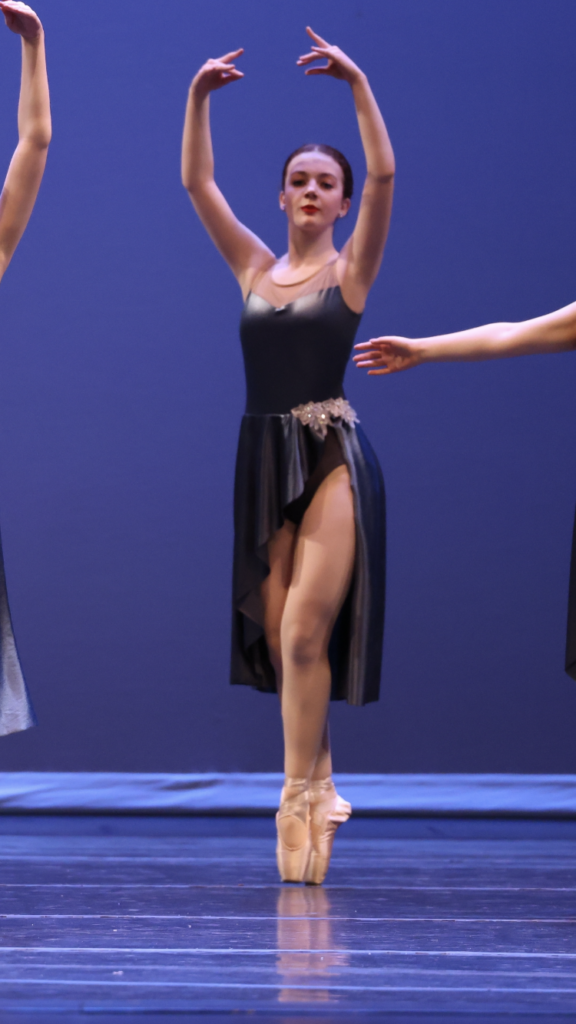Ballerinas willing to pay high price to perform

Alisha Soni | The Chronicle
For many, ballet is more than just a form of dance, it is a form of self-expression that can come at a cost.
Ballet is a popular type of performance dance that is meant to appear as effortless and graceful, but has been typically associated with a stigma of “toxic ballet culture.” In addition to the physical demands of ballet, the beauty standards and body image associated with the sport can take their toll on dancers.
Sophomore Nina Chatterjee was first put into ballet at three years old. Growing up, she has always held a passion for dancing and dedicated a lot of her time to learning its many different styles. Despite her love for dance, however, Chatterjee had to take time off from dance due to a skiing injury and, later, the Covid-19 pandemic. Although she has started dance classes again, she has not been able to fit ballet back into her schedule.
Internet searching topics such as eating disorders led Chatterjee to discover a link between ballet and negative views of one’s own body. Unlike society’s beauty standards, which popularize curves, the ballet form that many dancers strive for is a straight, or “flat,” body, with little to no curves. Chatterjee said that both society’s and ballet’s beauty standards make refraining from comparing herself to others a struggle.
“There are so many things [about your body] that you can’t change, but you wish you could,” Chatterjee said. “Then there are the things that you can only change in a very unhealthy manner [which becomes difficult] since the standard for what you want in a ballet body is not close to what society says.”
Despite feeling the body insecurities that come with ballet, Chatterjee has had an overall positive experience with ballet. While she does love ballet, Chatterjee has, however, also experienced the pressure that ballerinas face to be perfect. Ballet is extremely precise and dancers must pay close attention to detail, which is why Chatterjee said that many ballerinas endure the mental toll that comes with wanting to be good enough.
“Ballerinas have a lot of perfectionism and [commonly experience] imposter syndrome,” Chatterjee said. “There are a lot of times I’ll walk into class and think, ‘I’m not good enough to be here. I don’t deserve to be here.’”
In addition to the mental toll ballet can take, the physical exertion required of dancers is also evident. For sophomore Sydney Young, who started ballet at three years old, blisters, calluses, constant bruises, and occasionally lost toenails have become trivial scratches that come with being a ballerina. Young has also had her share of long-term ballet-related injuries. After overusing her knee, spraining her ankle, and even injuring her back, Young said that the hardest part of any injury is knowing when to take time out to recover.
“Knowing when to stop is hard because you think it’ll be fine [so] you just keep going,” Young said. “I’ve done that when I shouldn’t have, and you definitely risk making things worse.”
Although ballet is physically straining, there is a noticeable gender gap in terms of dance— especially with ballet. Young said that there is a huge stigma around men who dance because ballet is traditionally viewed as a more feminine activity.
“[Ballet] is definitely overlooked as being [an] easy sport only [done by] girls,” Young said. “Men are afraid to [dance] because of the judgment they might face at school. [But] it’s just as hard as any other sport, so they shouldn’t have to face that judgment.”
Any form of dance is a time-consuming commitment. Between school and ballet, there is limited free time that dancers like Young receive. Young said it is extremely important to balance time effectively.
“I try not to let [ballet] get in the way of school, but I’m not in as many clubs as other people or get a job during the school year because I’m at dance five days a week,” Young said. “But for me, [ballet] is worth it because I enjoy it so much and I love the people I dance with.”
The enjoyment Young feels while dancing with her team is shared by many ballerinas. For junior Sarah Schwartzkopf, who has also been learning ballet since she was three, her love for ballet makes the mental and physical impacts of ballet worth it. Schwarzkopf said that the close bonds with the other dancers at her studio and the positive dance environment push her to continue to learn ballet.
“I like ballet because it requires a lot of attention to detail and I feel like that’s just who I am,” Schwartzkopf said. “You get to express a lot of emotion through dancing and in my opinion [ballet] is one of the most expressive forms of dance.”
Despite the influence of toxic ballet culture, which involves oppressive body stereotypes and physical stress to dancers’ bodies, a positive dance environment can contradict these harmful effects. Sophomore Caroline Kayea said that regardless of body type, ballet can be fun if one has a passion for dance.
“Everybody who does ballet [is] their own unique, individual person,” Kayea said. “[Ballet] is a beautiful art form—it doesn’t matter what you look like or what shape or size you are. It’s just a matter of [if] you love what you’re doing. If you do, then who cares what other people say about it.”
Photo contributed by Caroline Kayea
